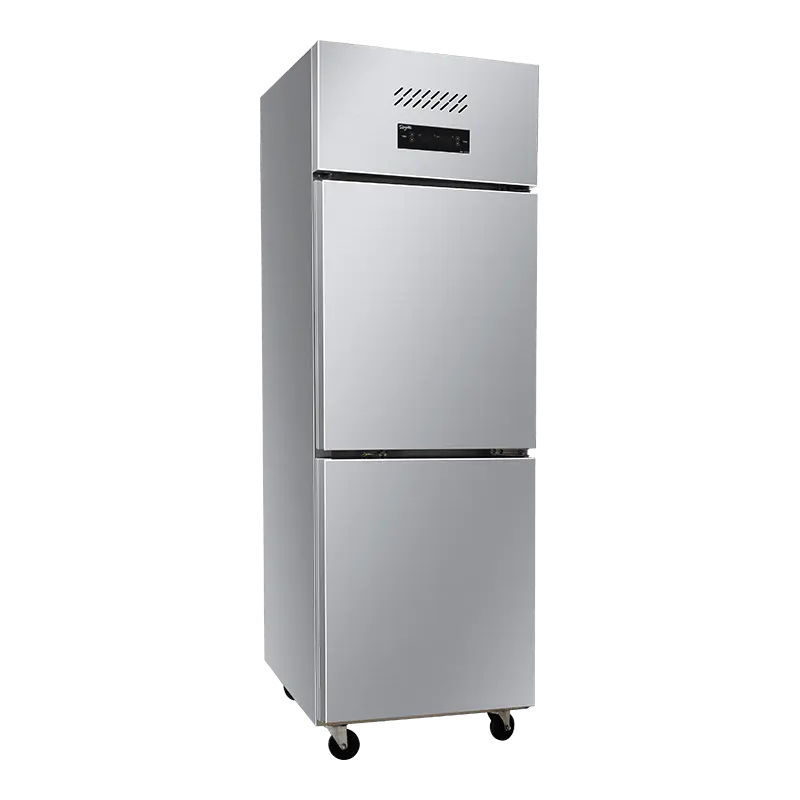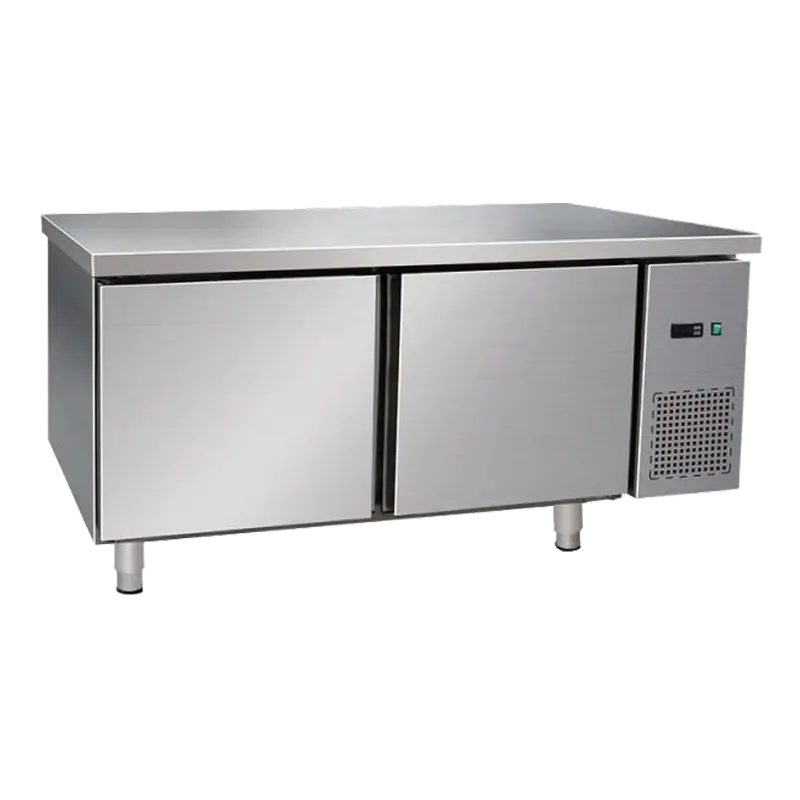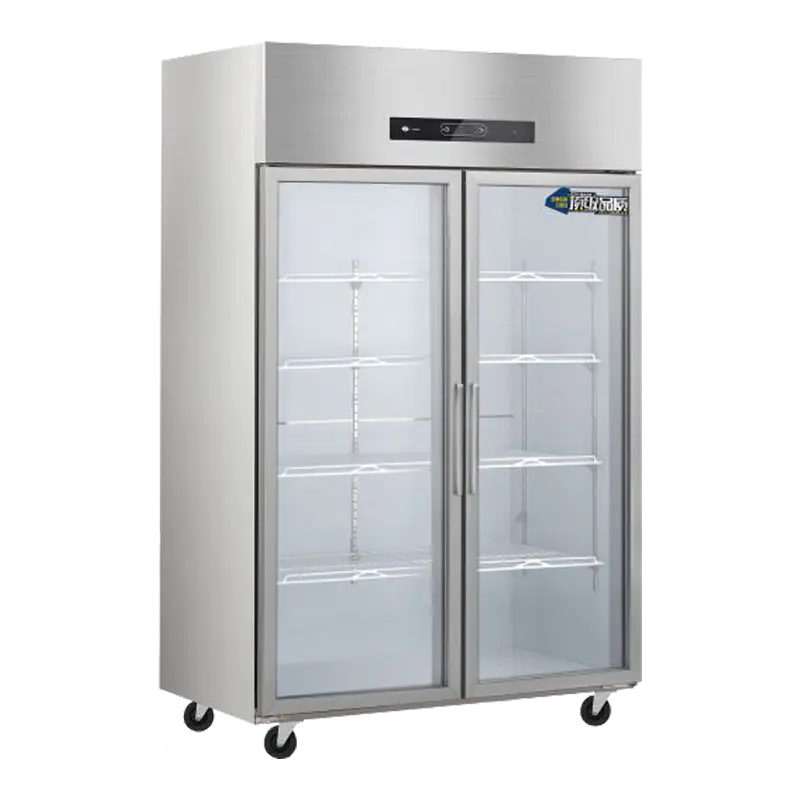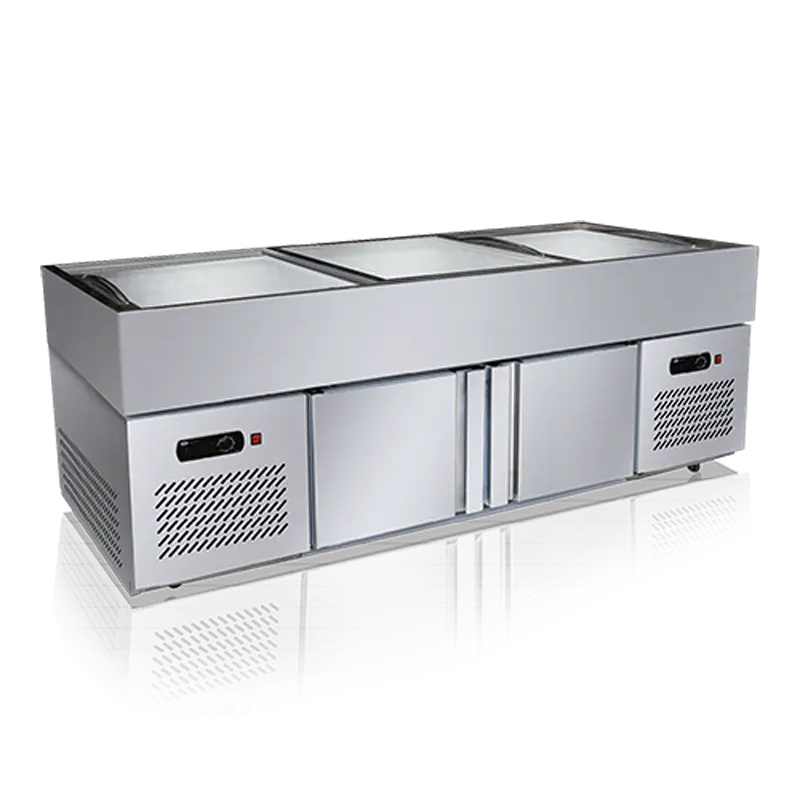Guarantee High Quality
With Our Expertise
Commercial Kitchen Refrigerators Manufacturers
-

-

-

-

-

-

High-Efficiency Heat Preservation Air-Cooled Kitchen Refrigerator
-

2m Glass Door Stainless Steel Ice Counter Kitchen Refrigerator
-

1.8m Three-Layer Step Stainless Steel Ice Counter Kitchen Refrigerator
Our commercial kitchen refrigerator series is built to provide stable cooling performance, ensuring that your ingredients stay fresh with consistent temperature control. We understand the demands of professional kitchens, which is why our refrigerators are designed to be reliable partners in your daily operations.
We offer a wide range of sizes and configurations to meet the needs of different kitchen environments. Whether you are running a small café, a busy restaurant, or a large-scale catering business, our flexible storage layouts help you keep everything organized and within easy reach, even during the most hectic service hours.
Energy efficiency has always been one of our priorities. By integrating advanced cooling systems and eco-conscious technology, our refrigerators reduce power consumption while maintaining top performance. This not only helps you save on operating costs but also supports your commitment to sustainability.
We also care about the comfort of your workspace. Our refrigerators are engineered for low-noise operation, minimizing disruptions in the kitchen and creating a calmer, more pleasant environment for your team.
Durability and usability are at the heart of our design philosophy. From robust exteriors to heavy-duty shelving, our refrigerators are built to withstand the rigors of everyday use. With intuitive controls and easy maintenance, our products go beyond being simple appliances—they are dependable tools that support your creativity and efficiency in a modern kitchen.

-
0 +Establishment year
-
0 ㎡Factory Area
-
0 +Number of employees
-
0 +Monthly production container
-
2025-12-26Mineral buildup (scale) is the most common preventable cause of slow ice production, cloudy cubes, and premature service calls. Scale forms when dissolved minerals—primarily calcium and magnesium—precipitate onto cold an...
-
2025-12-16What the “24 Hours” Really Means for an Ice Maker When manuals say “allow 24 hours for the ice maker to make ice,” they are usually describing time to reach normal, full ice production—not that the first cube requires a...
-
2025-12-08Common commercial uses by industry Commercial ice makers support very different workflows depending on the industry. Matching the ice type, production rate and footprint to the use-case reduces waste and operational prob...
Commercial Refrigerator vs. Household Models: Why Restaurants Shouldn’t Mix Them
Running a restaurant or catering business requires reliable food storage. While some new restaurant owners consider using a household fridge to save costs, this choice can backfire quickly. A commercial size refrigerator or a big fridge for restaurant kitchens is specifically engineered for high-volume, professional use — something a home fridge simply cannot handle.
Key Differences
Commercial restaurant fridges are built to hold large amounts of food, often with adjustable shelving and deep compartments.
Household fridges prioritize convenience for families, not bulk storage.
A commercial fridge for shop or restaurant use maintains stable temperatures even when the door is opened frequently.
Household units lose cool air quickly, leading to unsafe temperature fluctuations.
Commercial refrigerators use stronger compressors, stainless steel interiors, and heavy-duty door gaskets.
Domestic fridges are not designed for the heavy wear-and-tear of a busy kitchen.
Why a Household Fridge Is Risky for Restaurants
Food Safety Hazards: Temperature swings increase the risk of spoilage and foodborne illness.
Non-Compliance: Health inspectors often require certified commercial style fridges in restaurants.
Higher Long-Term Costs: A household fridge used in a commercial setting tends to break down faster, leading to more repairs and replacements.
Benefits of Choosing a Commercial Size Refrigerator
Reliable performance during peak service hours.
Larger storage capacity for fresh produce, meat, and beverages.
Professional design that supports both back-of-house and customer-facing areas.
Long lifespan when properly maintained.
Upright vs. Chest Commercial Style Fridges: Which One Fits a Big Restaurant Best?
Should restaurant owners choose an upright commercial style fridge or a chest-style commercial fridge? Both designs have advantages, but the right choice depends on your business model, kitchen layout, and food storage needs.
Upright Commercial Style Fridge
Easy Organization: Vertical shelving makes it simple to separate produce, meat, and dairy.
Quick Access: Staff can grab ingredients without bending or searching.
Space-Saving: Ideal for smaller kitchens where floor space is limited.
Best For
- Restaurants with limited back-of-house space.
- Cafés and bakeries that need frequent access to different food categories.
- Shops using a commercial fridge for display and quick service.
Chest Commercial Fridge: High Capacity and Long-Term Storage
Larger Volume: A big fridge for restaurant storage that can handle bulk items.
Better Temperature Stability: Cold air stays inside even when the lid opens.
Energy Efficiency: Consumes less power per liter of storage compared to upright models.
Best For
- Restaurants that buy ingredients in bulk.
- Catering companies storing large amounts of frozen or chilled food.
- Businesses needing long-term storage with fewer daily door openings.
Reducing Food Waste with a Commercial Restaurant Fridge
Food waste is one of the biggest challenges in the restaurant industry. According to global studies, up to 40% of food purchased by restaurants never reaches the customer’s plate. One effective way to combat this problem is by investing in a commercial restaurant fridge that provides the right storage environment to keep food fresh and safe for longer.
How Food Waste Affects Restaurants
Financial Loss: Spoiled ingredients mean higher operating costs.
Operational Stress: Running out of key ingredients disrupts service.
Sustainability Impact: Food waste contributes to environmental issues, which can damage a brand’s reputation.
The Role of a Commercial Size Refrigerator in Reducing Waste
A commercial style fridge maintains stable temperatures, even when opened frequently during peak hours. This prevents harmful fluctuations that lead to spoilage.
With adjustable shelving and deep compartments, a big fridge for restaurant kitchens allows staff to separate different food categories, reducing cross-contamination and forgotten items.
By providing consistent cooling, commercial refrigerators keep meat, produce, and dairy fresh for several extra days compared to household units.
Practical Tips for Using a Commercial Restaurant Fridge Effectively
Implement First-In, First-Out (FIFO): Store newer items behind older ones.
Label and Date Everything: Helps staff track freshness at a glance.
Avoid Overloading: Too much food blocks airflow and reduces cooling efficiency.
Use Clear Containers: Visibility reduces the chance of items being forgotten.
How to Extend the Lifespan of Your Commercial Size Refrigerator
Choose the Right Installation Location
Good Ventilation: Place the fridge where there’s enough airflow around the compressor and condenser.
Away From Heat Sources: Avoid installing near ovens, grills, or direct sunlight.
Level Surface: Ensures proper door sealing and prevents excess strain on components.
Monitor Loading and Usage
Don’t Overload: A stuffed commercial style fridge blocks airflow, forcing the compressor to work harder.
Avoid Frequent Door Openings: Train staff to gather ingredients at once rather than opening the door repeatedly.
Correct Temperature Settings: Stick to recommended ranges for chilled or frozen storage.
Schedule Regular Maintenance
Clean Condenser Coils: Dirty coils reduce cooling efficiency and strain the compressor.
Check Door Gaskets: A damaged seal lets cold air escape, increasing energy use.
Professional Servicing: Have a technician inspect your commercial restaurant fridge at least once a year.
Know When to Repair vs. Replace
Repair: Issues like worn gaskets, thermostat malfunctions, or minor leaks.
Replace: When repair costs exceed half the value of the fridge, or if the unit is over 12–15 years old.
Upgrading to a new commercial size refrigerator can also cut energy costs significantly.
Energy-Saving Tips for a Commercial Style Fridge in Restaurants
Optimize Temperature Settings
Set refrigerators between 1°C and 4°C (34°F – 39°F).
Set freezers around -18°C (0°F).
Avoid setting the temperature too low — it wastes energy and doesn’t improve food safety.
Improve Kitchen Layout
Keep your big fridge for restaurant kitchens away from ovens, stoves, and direct sunlight.
Ensure proper airflow around the compressor and condenser.
Poor placement forces the fridge to work harder to maintain cooling.
Maintain the Refrigerator Regularly
Clean condenser coils at least every 3 months.
Replace worn door gaskets to prevent cold air leaks.
Defrost when ice buildup exceeds 0.5 cm to maintain efficiency.
Solving Workflow & Layout Issues with a Commercial/Kitchen Prep Fridge
In many kitchens, the prep process slows down not because of the staff’s skills, but because of how equipment is positioned. A poorly placed commercial prep fridge can force chefs to walk back and forth, breaking the flow of preparation. Similarly, a kitchen prep fridge that is not integrated with the workbench may cause delays during peak hours, as staff struggle to grab ingredients quickly.
Solutions:
Integrate fridge and workstation – Choose a kitchen prep fridge with a built-in counter surface. This allows chefs to grab ingredients and immediately prepare them without moving across the kitchen.
Strategic placement – Position the commercial prep fridge within the main prep zone, ideally between cutting and cooking stations, so that multiple team members can access it without clashing.
Accessibility design – Opt for models with drawers or sliding doors, which reduce the space needed to open the fridge and make it easier to use in tight kitchens.
Workflow mapping – Before installation, map out how staff move during peak hours. Ensuring the prep fridge supports this flow can eliminate bottlenecks and improve overall speed.


 English
English русский
русский Español
Español عربى
عربى











